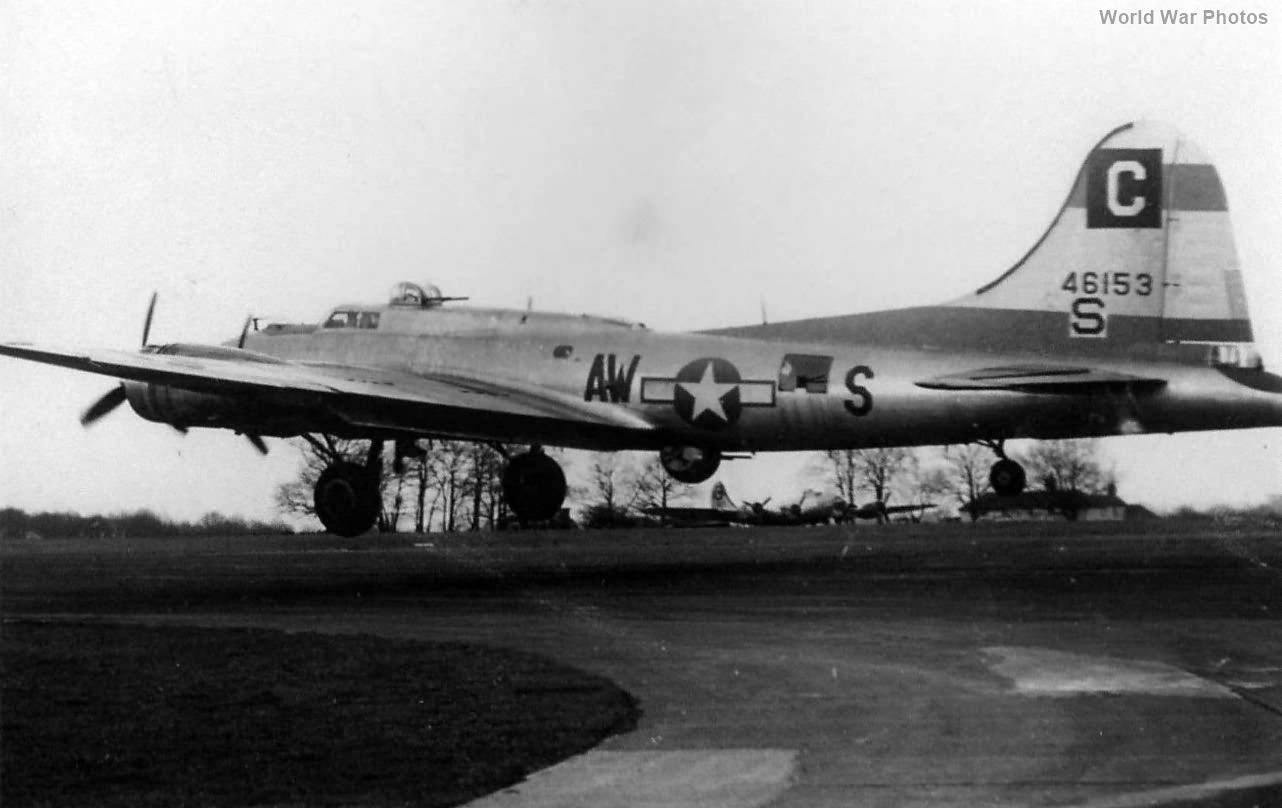The 96th Bomb Group (H)
Overview:
- Assigned to Eighth Air Force: April 1943.
- Combat Aircraft: B-17F (from blocks 70-BO, 45-DL, 30-VE); B-17G.
Wing & Command Assignments:
- 12 May 1943: VIII Bomber Command (BC), 4th Bombardment Wing (BW), 401st Provisional Combat Bombardment Wing (PCB).
- c. 23 June 1943: VIII BC, 4 BW, 403 PCBW.
- 13 September 1943: VIII BC, 3rd Bomb Division (BD), 45th Combat Bombardment Wing (CBW).
- 1 January 1944: 3rd Air Division (AD), 45 CBW.
Component Squadrons:
- 337th Bombardment Squadron (H)
- 338th Bombardment Squadron (H)
- 339th Bombardment Squadron (H)
- 413th Bombardment Squadron (H)
Stations:
- 16 April 1943 – 27 May 1943: Grafton Underwood (Air echelon only).
- 13 May 1943 – 11 June 1943: Andrews Field (Air echelon arrived 27-29 May 1943).
- 12 June 1943 – c. 11 December 1945: Snetterton Heath.
Group Commanding Officers:
- Col. Archie J. Old Jr. (6 Aug 1942 – 6 Sep 1943)
- Col. James L. Travis (6 Sep 1943 – Jun 1944)
- Col. Robert W. Warren (Jun 1944 – 27 May 1945)
- Lt. Col. Robert J. Nolan (27 May 1945 – late 1945)
Combat Record:
- First Mission: 14 May 1943.
- Last Mission: 21 April 1945.
- Total Missions: 321 (including five food missions in May 1945, delivering 366.1 tons).
- Total Credit Sorties: 8,924.
- Total Bomb Tonnage: 19,277.3 tons (including 131.6 tons of supplies).
- Aircraft MIA: 189.
- Other Operational Losses: 50.
- Enemy Aircraft Claims: 354 destroyed, 100 probable, 222 damaged.
Major Awards:
- Two Distinguished Unit Citations (DUCs):
- 17 August 1943: Regensburg (All 4 BW groups).
- 9 April 1944: Poznan.
Claims to Fame:
- Second highest MIA losses in the Eighth Air Force.
- Highest loss rate sustained by any Eighth Air Force group during the first five months of 1944.
- Led the first Shuttle mission from Regensburg to Africa on 17 August 1943.
Early History:
- Activated: 15 July 1942 at Salt Lake City Army Air Base (AAB), Utah. The group was formed at Gowen Field, Idaho, where it was officially established on 6 August 1942.
- Training: Moved to Walla Walla AAB, Washington, on 14 August 1942, then to Rapid City AAB, South Dakota, on 30 September 1942. It acted as an operational training unit at Pocatello AAB, Idaho, from 30 October 1942. The group then reverted to training for combat at Pyote AAB, Texas, on 3 January 1943.
- Overseas Movement: The air echelon began its overseas movement on 4 April 1943, taking the northern ferry route via Presque Isle, Newfoundland, and Iceland to Prestwick. The ground echelon left Pyote on 16 April 1943 for Camp Kilmer, NJ, and sailed on the Queen Elizabeth on 5 May 1943, arriving at Greenock on 11 May 1943.
Subsequent History:
- Post-War: The group was initially scheduled for occupational duties in Germany, but plans were revised in September 1945. During the latter part of 1945, the group flew training and transportation flights over Europe. It was assigned to the 1st Air Division on 12 August 1945 but reassigned to the 3rd Air Division on 28 September 1945. The aircraft were flown back to the U.S. or transferred to continental units in November 1945. The squadrons were inactivated, and the remaining personnel left Snetterton in early December 1945, sailing on the USS Lake Champlain on 12 December 1945. They arrived in New York on 20 December 1945, and the group was inactivated at Camp Kilmer, NJ, on 21 December 1945.
Aircraft Markings:
Original B-17Fs: Dark Olive Drab and Neutral Gray factory finish.
Squadron Codes:
- 337th Bomb Squadron: AW.
- 338th Bomb Squadron: BX.
- 339th Bomb Squadron: QJ.
- 413th Bomb Squadron: MZ.
Square C: The group insignia, introduced in early July 1943, was a white square approximately 48 inches high by 54 inches wide, with variations in size. The insignia had a 36-inch high Insignia Blue “C”. The call letter was painted under the tail number in yellow, 24 inches high. The Square C on the right wing followed instruction size: 72 inches by 60 inches.
Fuselage Identification Letters: From the autumn of 1943, the squadrons began painting fuselage identification letters in white for clearer recognition, although light grey was still used on some aircraft. With the arrival of bare metal-finished B-17Gs in March 1944, letters were painted in black and the group insignia was white on black.
Squadron Colors: In July 1944, squadron colors were introduced with a 5-inch band aft of the nose Plexiglas; the 337th used red, the 338th yellow, and the 339th dark blue, while the 413th did not have a color. These markings were not applied to all aircraft and were largely discontinued early in 1945.
Red Bands: In late January 1945, two red parallel bands were painted on the upper surface of the right wing and lower surface of the left wing, as well as on both sides of the vertical tail surfaces. The width of the bands was mostly 36 inches, with a 60-inch separation.
